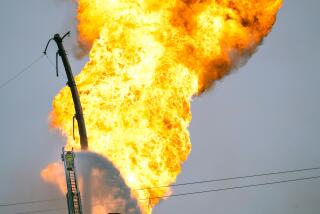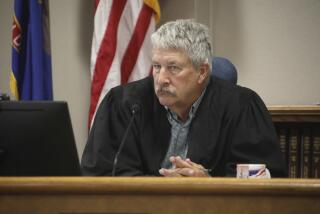Clashes, arrests and fears — North Dakota pipeline protest at a boiling point

On Oct. 22, North Dakota police arrested 126 people during what activists say was a peaceful prayer meeting at their encampment.
Reporting from Along the Cannonball River, N.D. â Robby Romero and his fellow Native American activists have drawn a clear line on the cold North Dakota ground.
âThis is our stronghold,â Romero said. âThey will not cross this line.â
The line is North Dakota Highway 1806, which runs through the Standing Rock Sioux reservation, near where the Fortune 500 company Energy Transfer is building a $3.78-billion. 1,172-mile-long crude oil pipeline on lands adjacent to the reservation.
Since August, the tribeâs assertion that sacred tribal sites have been desecrated and fears that the pipeline could contaminate the nearby Missouri River have galvanized American Indian tribes and their supporters more than any struggle in decades.
Native peoples from across the United States and Canada, and as far away as Central America and Norway, along with thousands of nonnative supporters, have flocked to a series of encampments along the Cannonball River. They gather adjacent to the reservation, mostly on lands controlled by the Army Corps of Engineers but which were awarded to the Dakota and Lakota peoples in an 1851 treaty, then taken away.
The Standing Rock tribe has attempted to block construction in federal court, but on Oct. 9, an appeals court in Washington denied the tribeâs petition. The next day construction on the pipeline resumed despite a request from the Obama administration for a voluntary halt. Though the administration has suspended permission â for now â for the pipeline to cross under the Missouri River, Energy Transfer and the state of North Dakota appear determined to build right up to the waterâs edge.

A federal judge is set to deliver a key ruling on the four-state Dakota Access pipeline that has drawn thousands of protesters to a construction site in North Dakota in recent weeks. U.S. District Judge James Boasberg said he will rule by the end of
Romero says native peoples are determined to take back the lands in the path of the pipeline, which could transport 570,000 barrels a day from the Bakken oil field in northwestern North Dakota to southern Illinois â more than the daily output of Ecuador, a member of OPEC.
Over the weekend, with construction crews a mile or so from Highway 1806, the protesters, who prefer to be called âwater protectors,â began moving teepees and tents directly into the path of the pipeline on private land.
âThis is sacred ground,â said Romero, in a beret, with a short graying ponytail and sunglasses. He pointed to the growing new encampment, now dotted with about 14 teepees and several dozen tents on land that was nearly vacant two days earlier. âWe are claiming eminent domain.â
On Saturday, during what activists say was a peaceful prayer meeting at the encampment, North Dakota police arrested 126 people, using Mace and batons to disperse the group, and shot down a drone protesters were apparently using to scout authorities, according to numerous witness accounts. Since Aug 10, police have arrested 269 protesters, according to official figures.
The protests are in fact riots, says Cass County Sheriff Paul Laney, who is coordinating the police response. âWhen you have that many people engaged in that kind of behavior, inciting others to break the law, cheering others on as they do break the law, refusing to leave when theyâre asked to leave, thatâs not a protest,â Laney said at a recent news conference.
The response from North Dakota officials has been forceful. Gov. Jack Dalrymple called in the National Guard. Sheriffâs deputies have been brought in from as far as Wisconsin. Police man a concrete checkpoint north of the protest sites. Demonstrators are regularly met with dozens of police in riot shields, along with police vans and armored personnel carriers.
Authorities said they could have arrested thousands of protesters had officers not exercised âunbelievable restraint.â
âIt is because of the behavior of the state that these tensions are heightened,â countered Standing Rock Chairman David Archambault II, who called on the Justice Department to intervene.
âThey put the blockade up. They have low-flying planes theyâve brought in. And theyâre the ones who use the terminology âterrorist.â So if thereâs a heightened level of confrontation, itâs not because of what the demonstrators are doing when they walk down that road to protest the construction thatâs going on.â
On Monday afternoon on Highway 1806, as a yellow helicopter and a light plane circled above the camp, another clash between police and demonstrators appeared imminent.
Organizers rolled hay bales and dragged heavy logs onto the road, fearing convoys of police that their new surveillance drone had apparently scouted. But then another organizer yelled at the group to remove the blockade and redirect their energies to a gravel road where police forces were said to be approaching from the west.
But on this day, no advancing conveys appeared. Yet for some, the worry generated by weeks of surveillance is taking its toll.
âIn the beginning, we felt really welcome,â said Paige Restoule, 29, who drove 24 hours nonstop with her two cousins from the Dokis First Nation reserve in northern Ontario, Canada.
But when police came Saturday, Restoule said she watched as demonstrators on the front line were sprayed with Mace. âThey were begging them to stop. It is a little bit horrifying.â
Authorities used the pepper spray sparingly and defensively after protesters âbreached our line,â said North Dakota Highway Patrol Capt. Brian Niewind. A camp medic, however, said some of the protesters who had been sprayed did not appear to be resisting arrest.
The resolve of the water protectors appears strong, even if the estimated 1,200 camp residents â down from a high of 5,000 in the summer â are small compared with the force that North Dakota could ultimately employ.
âBut you canât fight prayer,â Restoule said with a smile. âThatâs what keeps us together. We are not alone.â
Just ahead, on a hillside, two young men, one Lakota and one Dakota, sat still on horseback, facing west. They were security scouts and would identify themselves only as âspirit riders.â One of them gazed through his binoculars at a pipeline work crew slowly making its way east toward the highway.
âWeâre trying to protect our future,â he said.
Tolan is a special correspondent.
ALSO
âSerialâ podcast subject Adnan Syed asks for release from prison
Congress knew for at least two years about Pentagon efforts to take back bonuses from veterans
More to Read
Sign up for Essential California
The most important California stories and recommendations in your inbox every morning.
You may occasionally receive promotional content from the Los Angeles Times.










